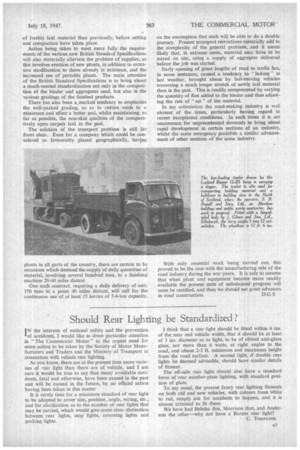Is the Road-making Industry Abreast of the Times?
Page 40

Page 41

If you've noticed an error in this article please click here to report it so we can fix it.
IN these days of great technical achievements, when the exceptiona[ is frequently regarded as commonplace, it is hardly reasonable to expect that the little-publicized successors of the road-making industry should have been generally recognized. Scant attention has been paid to the great work done during the past few years in laying vast areas of materials in the construction of aerodromes and new roads, and, latterly, in renovating neglected surfaces.
Nevertheless, marked progress has been made. Modern mechanical equipment has been evolved for laying and finishing road materials, and new British Standard Specifications for materials of all types and gauges have been introduced. Developments have also been made in soil stabilization, although this branch of civil engineering has not yet influenced British general policy of road construction and may still be regarded as in its early infancy. The results of research may, however, cause a drastic change in the approach to the subject of road foundations.
It was unfortunate that the rapid development in the technique of laying macadam by mechanical means should coincide with a period when manufacturers were limited in the action that they could take to effect a compensatory increase in rate of production. This would normally involve the erection of further plants and large modifications to existing plants, units for which have not been available during these years of restrictions.
The result of what might thus be termed " unbalanced progress" has been that manufacturers have had to
meet to the best of their ability the requirements of a greatly increased daily capacity, caused by the evermounting number of authorities using road-finishing machines, without a corresponding rise in rate of production. These machines probably represent the greatest single advance made in implementing road construction during recent years, and their use has enabled a comparatively small gang to lay a quantity of macadam three to five times greater than that which could previously have been laid by a larger gang in a similar period by hand.
The advent of finishing machines has confronted the manufacturers of road materials with many problems. One is to maintain adequate supplies to contracts where a finishing machine is in use, whilst, at the same time, not neglecting small deliveries to old and valued customers still laying by hand.
Another difficulty is to provide adequate transport to deliver a large daily tonnage at constant and frequent intervals, this naturally being greatly influenced by the distance factor. Thirdly, manufacturers have to combat the effect of opening to traffic much greater lengths
of freshly laid material than previously, before setting and compaction have taken place.
Action being taken to meet more fully the requirements of the various new British Standard Specifications will also materially alleviate the problem of supplies, as this involves erection of new plants, in addition to extensive modification to those already in existence, and the increased use of portable plants. The main intention of the British Standard Specifications is to bring about a much-needed standardization not only in the composition of the binder and aggregates used, but also in the various gradings of the finished products.
There has also been a, marked tendency to emphasize the well-packed grading, so as to reduce voids to a minimum and effect a better seal, whilst maintaining, as far as possible, the non-skid qualities of the comparatively open carpets laid in the past.
The solution of the transport problem is still far from clear. Even for a company which could be considered as favourably placed geographically, having plants in all parts of the country, there are certain to be occasions which demand the supply of daily quantities of material, involving several hundred tons, to a finishing machine 20-60 miles distant.
One such contract, requiring a daily delivery of only 150 tons to a point 40 miles distant, will call for the continuous use of at least 15 lorries of 5-6-ton capacity, on the assumption that each will be able to do a double journey. Present transport restrictions materially add to the complexity of the general problem, and it seems likely that, in extreme cases, material may have to be mixed on site, using a supply of aggregate delivered before the job was started.
Early opening of great lengths of road to traffic has, in some instances, caused a tendency to "licking" in hot weather, brought about by fast-moving vehicles traversing a much longer stretch of newly laid material than in the past. This is readily compensated by varying the quantity of flux added to the binder and thus adjusting the rate of " set " of the material.
In my submission the road-making industry is w!il abreast of the times, particularly having regard to recent exceptional conditions. In such times it is aot uncommon for unprecedented demands to bring about rapid development in certain sections of an industry, whilst the same emergency prohibits a similar advancement of other sections of the same industry.
With only essential work being carried out, this proved to be the case with the manufacturing side of the road industry during the war years. It is safe to assume that when plant and equipment become more readily available the present state of unbalanced progress will soon be rectified, and then we should see great advances in road construction D.G.S




















































































